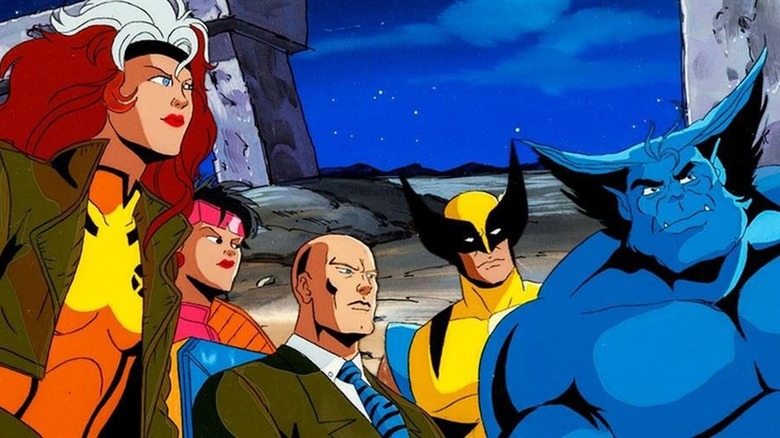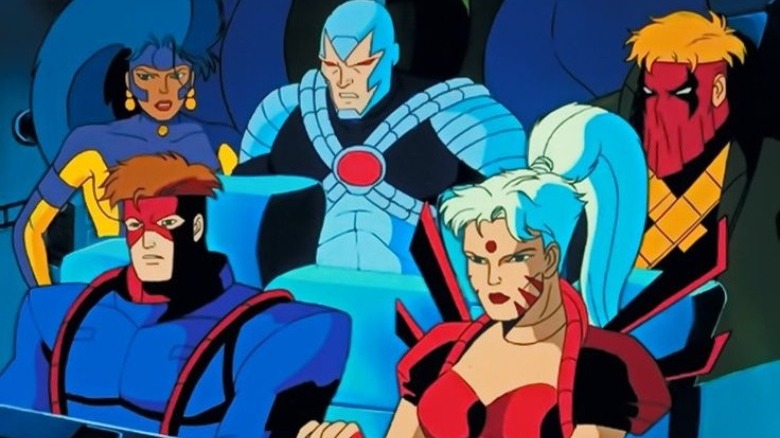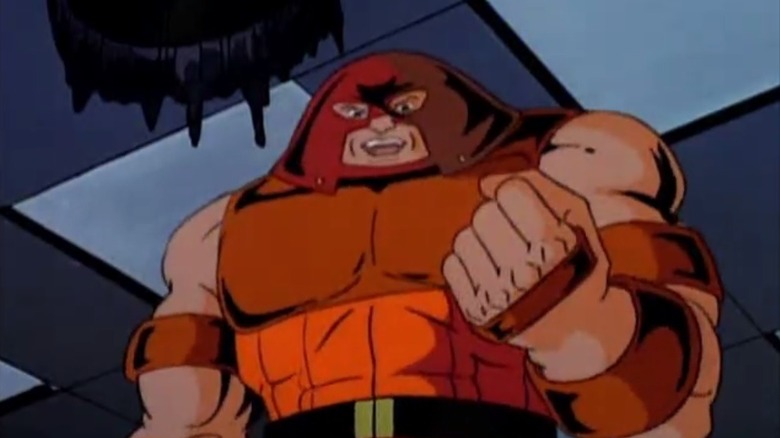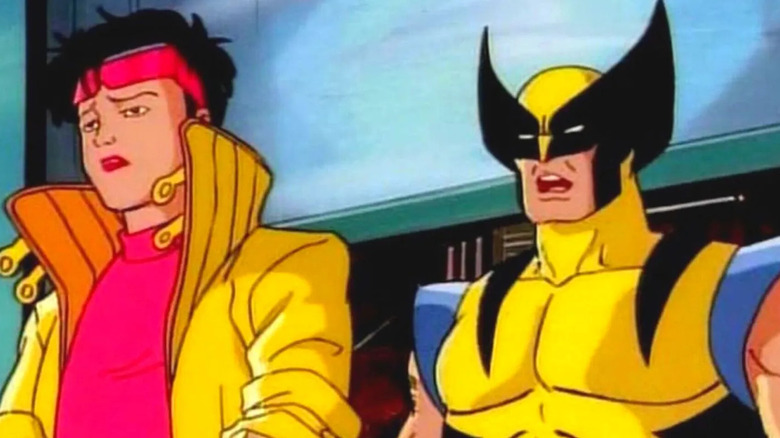X-Men: The Animated Series Pulled A Trick On Marvel To Get The Show Approved
When the X-Men debuted in the pages of Marvel Comics back in 1963, their superhero costumes looked a little more like school uniforms. The team at the time was made up of the characters Cyclops, Ice Man, Beast, Marvel Girl, and Angel, and they all wore a notable yellow-and-blue ensemble with hoods to partially cover their faces. "The Uncanny X-Men" also allowed creators Stan Lee and Jack Kirby to skip over the bothersome task of having to invent a superhero origin story. Rather than a tale of cosmic rays, gamma radiation, spider-bites, or some other powers-granting conceit, the X-Men were merely born with their abilities. They are mutants.
When the X-Men universe expanded to include more and more characters, the blue-and-yellow ensembles gave way to a wide variety of outlandish costumes, each one adhering to the styles of the day. Those who read X-Men comics in the 1990s, for instance, will likely recall the abundance of leather jackets worn over spandex tunics. And pouches. So ... many ... pouches. In 1992, the original "Uncanny" comic was rebooted with an all-new "X-Men" #1, featuring a notable costume overall drawn by veteran superhero artist Jim Lee. For a generation, the 1992 costumes became the new standard for the X-Men's design.
Lee's 1992 costumes were also what the makers of "X-Men: The Animated Series" used when designing the X-Men characters for the small screen. The '90s color scheme and the design were ported over directly. Sadly, because of politics involving the then-nascent Marvel competitor Image Comics, those designs were almost not used. In the 2003 book "Previously on X-Men: The Making of an Animated Series" by Eric Lewald, writer Will Meugniot revealed that he had to hoodwink the studio into accepting Lee's 1992 designs.
Remember Wild C.A.T.s?
'90s kids likely remember Image Comics. It was a company founded by a group of dejected artists for Marvel Comics and DC Comics who felt that the whole industry was unfair to artists. Briefly, Image Comics allowed artists to create their own characters and work on their own schedules. What resulted was a high-profile series of books that looked amazing, but, one might hasten to point out, had terrible stories and characters. Image Comics rolled very, very hard into the trends of the day, creating an entire universe of limp, "extreme" superhero characters.
Jim Lee's Image book was called "Wild C.A.T.s," a comic about two warring alien factions and the high-octane superhero team that gets caught up in the conflict. The characters were awful, and the mythology was complicated to the point of being incomprehensible. Regardless, "Wild C.A.T.s" and the rest of the Image line were massively popular among readers — collectors hoarded all those new #1s — and the company began to pose a serious threat to Marvel and DC.
Meugniot didn't care about Image, but the Marvel execs did, and using Jim Lee's designs was a no-no. He recalled:
"My goal at that point was to do something as close to the contemporary comics (early 1992) as possible, so we started with the Jim Lee designs (among many available). But we had this side-trip off of them because shortly after we started after I had gotten the initial designs of Wolverine, Cyclops, and Jean approved, suddenly I got a note from Marvel saying, 'You have to put away all the Jim Lee references. We can't do a show that looks like his stuff.'"
And why not? Well, over at Image Comics, Lee was a co-founder.
The trick
Jim Lee was one of seven founders of Image Comics alongside other Marvel luminaries like Todd McFarlane, Rob Liefeld, and Erik Larsen. For Marvel, one of their star X-Men artists had just become a thorn in their side, and it seemed that's why they wanted Lee's designs to be abandoned. "They wouldn't say why," Meugniot said, "But of course, the problem turned out to be that Jim and the other major Marvel guys had announced that they were leaving to found Image Comics."
Meugniot was determined to use Lee's designs, however, because, well, they had instantly become the new standard. He felt that viewers would respond better to the "official" look than to something old-fashioned from the 1960s. In order to force Marvel's hand, Meugniot cleverly pulled an old ploy by creating the illusion of leadership. He presented two costume designs to the Marvel bigwigs. The one he wanted and the one he knew would be rejected. He said:
"I knew that we had to use those costumes because that was what people who like the characters were going to expect (and they worked best). I thought, well, [to fight it] I'm going to do a model sheet that's so dumb that they will be forced into using the right ones. So I did a completely wrong, young/funny Hanna-Barbera, 1970s version of the team."
Sadly, those designs have not survived, so we can only imagine how awful they were. Regardless, Meugniot's scheme worked. So well, in fact, he ended up frightening Stan Lee himself. Given the silly costumes Lee signed off on throughout his career, Meugniot's designs must have been pretty damn wild.
Tricking Stan Lee
Meugniot's bosses were shocked by his "rejactables," and that shock went all the way up. Meugniot said:
"I sent it in. We had just added artist/designer Rick Hoberg to the mix on the crew. Rick wasn't aware of the politics, and when he got the Hanna-Barbera versions, he about had a heart attack. He was on the phone to Stan and others, horrified, saying, 'We can't do this, we can't do that, what is Will thinking?! He's going to ruin the show!' It worked out well that Stan sincerely thought I was being an idiot for doing the wrong designs that upset Rick so much."
Meungiot did acknowledge, however, that this ploy does pose a risk. No matter how terrible his "reject" designs were, he knew there was likely someone in the pipeline who would have liked them. There is always going to be a slim chance that your deliberately bad ideas will be given the green light. Meugniot was lucky in that everyone seemed to legitimately hate his 1970s ideas. Once presented with a horrible version, everyone calmed down, Jim Lee's look was adopted, and the known look of the show was formed. Now work could begin. Meugniot said:
"After that they realized that they had to do the version that was more like Jim Lee, so we took the Lee costume designs and made them a little bit more animate-able. Then Rick's line work unified it into that cohesive style. That's when I started shifting off character design more to focus on story ... and then the day-to-day operation of the show, trying to make sure it didn't go off the tracks."
The show lasted for five seasons. In 2024, it will be revived on Disney+ in the form of "X-Men '97."



